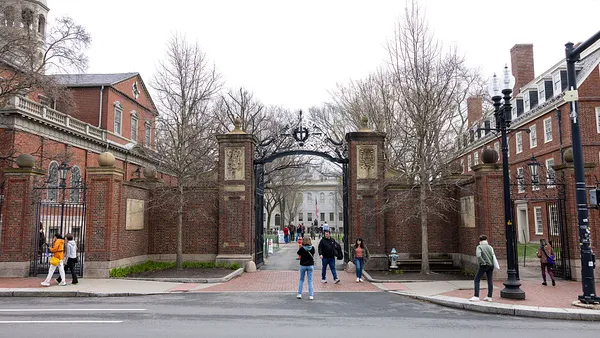As college costs grow, so too does the pressure on institutions to manage them. Between the 2008-09 and 2018-19 academic years, the average posted price for tuition, fees, and room and board rose an inflation-adjusted 25% to $48,510 at private nonprofit colleges and 30% to $21,370 at public institutions, according to data analyzed by The College Board.
Along with the push to lower costs is the desire for colleges to be more transparent about what students and their families will be required to pay. To that end, the U.S. Department of Education issued guidance earlier this year advising colleges to avoid using words like "award" to describe student loans and work-study. It also recommended breaking down the cost of attendance to parse out components such as housing, food, supplies, transportation and medical insurance.
Some institutions are doing more to help connect their students with gap financing, public benefits and affordable child care. Beyond that, policy efforts are vying to make students' financial aid paperwork easier to understand to ensure they can maximize their benefits.
Still, institutions often struggle to help students understand how much attending college will cost them, said Eddy Conroy, assistant director of community engagement and research application at the Hope Center for College, Community and Justice. He is one of a group of researchers that will be working with six institutions across Texas to develop best practices for communicating costs to students.
The new initiative is backed by a $650,000, 18-month grant from the Lumina Foundation and expands work being done in Texas, which features prominently in federal education policy debates.
"We chose the state first, and then we started going about inviting colleges and universities that are already doing some of the 'real college' work that we see as important and on the leading edge," Conroy said. "These are all colleges that are trying to do their best to do more for students with the resources that they have. And they're really looking at students as humans first."
Education Dive spoke with Conroy about the upcoming project and how colleges can be clearer with students about what they can expect their costs will be.
This interview has been edited and condensed.
EDUCATION DIVE: The group contains two- and four-year colleges. Are you expecting different challenges or solutions based on their type?
CONROY: We anticipate seeing more students with negative expected family contributions (EFCs) at two-year colleges and greater capacity to use institutional and emergency aid at four-year colleges. There's almost always a mismatch between colleges that have the most students with unmet need and the colleges that have the resources to help.
Cost of attendance estimates tend to be more complex at four-year institutions because they are more likely to have students living on and off campus. We're seeing two-year colleges start to do more to connect students to public benefits they are eligible for but may not be aware of, like SNAP and WIC. We're hoping to encourage an increase in that type of work, too.
How will the project address EFCs?
CONROY: The EFC helps determine how much financial aid a student is eligible for. But those formulas truncate to zero within the federal system, and in some cases, students would actually have a negative figure. We want to help colleges see that there's a lot more differentiation than currently recognized among students who have zero EFCs.
One of our team members — Robert Kelchen, a professor at Seton Hall University — has done some of this work already. We're going to rerun the federal formulas and allow the negatives to generate.
And then what?
CONROY: We're an action research center, which means we always want to do more than just look at challenges. So we're going to help colleges look at ways they can better communicate these issues to students and potentially how they can use this information to identify students who might need additional support.
We're also going to do some technical assistance around positive practice with emergency aid or helping students access public benefits. Some of the colleges are already doing this. We want to bring the institutions together to help them learn from each other as well as to get our guidance and assistance.
How might you help the colleges communicate this to students and their families?
CONROY: We will create some short, animated videos to get students thinking about why the financial aid system is challenging and about how, in some cases, colleges are having to estimate, even guesstimate, students' costs.
Students look at their cost of attendance and sometimes think, "This doesn't look at all accurate to what I know my costs would be." We're going to use the interactive material to get them thinking about that and about how they can help themselves get the resources they need. We want to tread a fine line between encouraging students to look for support but also not discouraging them from continuing their education.
Why is there such a disconnect between how colleges and students perceive this cost?
CONROY: The disconnect is really between the federal government's and students' views on the cost of attendance. By and large, colleges are doing what the federal government says they have to do in terms of developing a cost of attendance based on tuition, room and meals, books and supplies, transportation and some estimate of personal expenses. Tuition is pretty simple, but it could look different for even on-campus students at a four-year college. Figuring out off-campus housing and food costs is also a challenge.
Colleges aren't terribly well equipped to do this, so they're doing their best to figure that out but we're seeing that often those estimates miss the mark. Part of this has to do with the formulas that underlie FAFSA being outdated. Too low and students don't have enough resources; too high and we might be encouraging students to borrow more than is ideal. Getting this right is really important.
What's an example of that imbalance today?
CONROY: Colleges will assume living at home with family has a very low or no cost to the student. We know from our work that often students living at home are contributing to household expenditures. Increasingly, we see that colleges and the federal government have this idea that if a student is living at home then they probably don't have a lot of expenses or bills to pay. When we survey students, we find that quite a lot of them are helping to pay for expenses living with family.
Colleges may feel pressure to become more transparent, but you note the way students are vetted for aid doesn't always match up with their financial realities. Is there a risk to colleges about being fully open if that doesn't change?
CONROY: Colleges are often doing their best within a quite unhelpful structure of federal regulations. We don't want to discourage students from entering higher education. How we talk about these things is really important, so there may be some small risk to colleges.
On the other hand, there is probably a benefit in additional transparency because it is what will help change federal policy. If we constantly pretend things are OK, then it becomes much harder to shift federal policy in a positive direction. If we can recognize that the system is undercounting students' financial need, then maybe we can get policymakers to shake it up a little bit.
In what areas would transparency have the biggest impact?
CONROY: Colleges having better ways of determining their off-campus housing costs. Right now, we're asking administrators who are already overburdened to figure out what the rental market in their area looks like. That's not a job most college administrators have the expertise to do.
The Ed Department could address that by creating a more uniform way for colleges to calculate cost of attendance; that could include requiring they use a particular data set, which they don't have to now. We see colleges in the same part of a city having very different costs of attendance. Another way is by reflecting in federal data that students living with family may have housing costs.
Do you see any colleges taking a very active stance in addressing this?
Not so far, and that's partly because that kind of work is expensive, and without guidance from the Ed Department, there is limited incentive for colleges to change their ways. We see colleges increasingly pushing students toward resources outside of the traditional financial aid system, such as public benefits and food pantries.
Private institutions have tried to manage cost increases through tuition resets and more grant aid.
CONROY: That's an important coda. We don't see a lot of tuition resets and increases in grant aid in the public sector, which is where about three-fourths of Americans attend college. Often those institutions don't have that flexibility even if they might want it.
We're not focusing the project on those kinds of issues. It's really about looking at the fundamental numbers in the need equation and asking how well can you estimate a student's true need with a form. We're going to stretch this project as best as we can within existing policies and perhaps point toward where policy reform is needed.





















